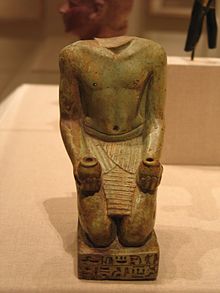Meshwesh
The Meshwesh are known from ancient Egyptian texts as early as the 18th Dynasty, where they are mentioned as a source of cattle provided to king Amenhotep III's palace at Malkata.They still used the same robes as before, a thin mantle of antelope hide, dyed and printed, crossing one of their shoulders and coming down until mid calf length to make an open robe over a loincloth with an adorned phallus sheath, being the only exception of the new addition of a kilt above the knees and an animal tail in the Egyptian manner of king Narmer and the phallus adornment over it.During the following reign, that of Ramesses II, the Egyptians constructed a series of coastal fortresses running west to the region of Marsa Matruh, including at al-Alamayn and Zawayat Umm al-Rakham.Unlike his predecessors, Merenptah states in his battle reliefs at Karnak that it was primarily the Libu tribe who led the conflict, but that Meshwesh and Sea People allies were also involved.This time, it was the Meshwesh who instigated the conflict, though other Libyan tribes and their Sea People allies were involved in fighting two major campaigns against the Egyptian king, in Ramesses III's Regnal Years 5 and 11.Throughout the 20th Dynasty, various texts on ostraca and papyri mention attacks by Meshwesh tribesmen as far south as Thebes, where the workmen of Deir el-Medina were forced to seek protection inside the mortuary temple of Medinet Habu.



hieroglyphsEgyptianancient LibyanBerberSea PeoplesEighteenth Dynasty of EgyptAmenhotep III21st DynastyOsorkon the ElderSiamunPsusennes IIpharaohsShoshenq IOsorkon IOsorkon IIShoshenq IIIOsorkon IIILibyanstela of PasenhorShoshenq VBerber languagesHecataeus of MiletusHerodotusMazices and MazaxRamesses II18th DynastyMalkataAkhenatenpapyrusNarmertunicsBrooklyn MuseumLibyansEgyptiansRamesside PeriodKarnakSeti IEgyptian languageMarsa Matruhal-AlamaynMerneptahSea PeopleMerneptah SteleRamesses IIIconcentration campsPapyrus Harris IThird Intermediate PeriodHerakleopolis Magna20th DynastyostracaThebesDeir el-Medinamortuary templeMedinet HabuMendesSebennytosBusirisPer-SopduPharbaithosAncient LibyaBerbersBavaresGaetuliGaramantesKoidamousii/UcutumaniLeuathaeMachlyesMarmaridaeBakouataeMauretaniaMusulamiiNasamonesNumidaeMasaesyliMassyliiNumidiaQuinquegentianiPsylliBarghawataGodalaGuanchesHawwaraKutamaSedouikechLuwataMasmudaHintataSanhajaLamtunaZanataBanu IfranJarawaMaghrawaChaouisChenouasGhomarasJerbisBerber JewsKabylesMozabitesRiffiansShilhaTeknasTuaregsZayanesTribesScriptLatin scriptReligionArab-BerbersArabized BerbersBerber diasporaBelgiumCanadaFranceNetherlandsUnited StatesBerberismKabyle nationalism